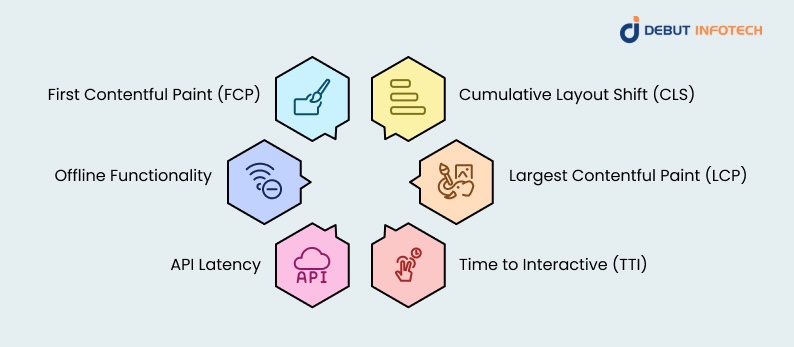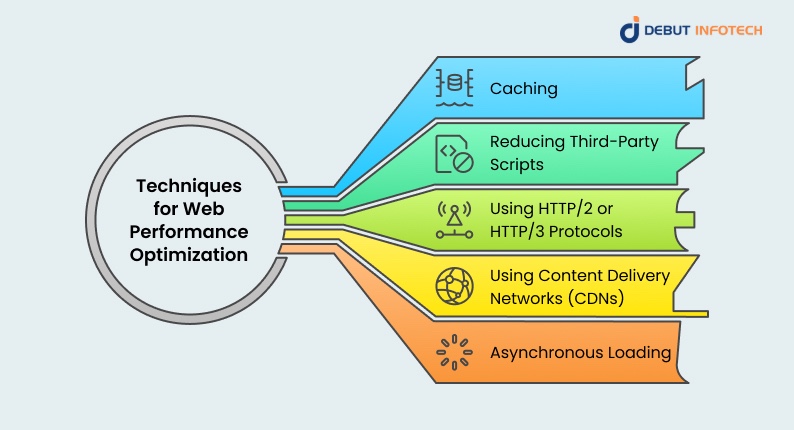Table of Contents
Home / Blog /
Top Web Performance Optimization Techniques to Boost Speed and Reliability
August 4, 2025

August 4, 2025
Have you ever clicked on a website, waited a few seconds too long for it to load, and then closed the tab out of frustration? You’re not alone. In the modern competitive digital environment, people using websites demand that their apps load immediately and function without latencies. Indeed, research demonstrates that rather than wait more than three seconds, most users just drop their web applications resulting in increased bounce rates and missed conversions.
The twist though is that developing feature-rich applications is all good but without speed and scalability, even the brightest ideas lose their luster. That is why web application performance optimization ceased to be a mere “nice-to-have”, but is a must-have skill for every serious developer.
How then can the developers enhance performance without compromising the robustness and scalability of their apps, potentially even when working with a web development company? Which tools and best practices should one be aware of? And how are the developers supposed to know that their improvement plans are hitting the mark?
In this guide, we break it all down. We will cover everything involved when it comes to building fast, responsive and reliable web applications in the year 2025 and beyond, including real-world optimization practices, performance testing tools and monitoring strategies.
Without further ado, let’s delve in!
Understanding the Fundamentals of Website Performance
A well-performing and quickly loading site helps improve user experience and engages them, which may result in more traffic or a larger number of sales. Conversely, a slow or underperforming site may irritate users, who then may abandon it and consequently damage the reputation of the brand.
Page load time is one of the most important performance-related indicators also known as the time that the web page takes to completely appear on the user browser. Google advises that websites should take less than three seconds to load but most websites take more time because of such things as large media files, poor code or an unreliable host, often requiring custom software development solutions.
Another major factor is the responsiveness of the websites. This quantifies the responsiveness in the actions between the user and the site through interactions, clicks, or scrolls.
SEO (Search Engine Optimization) also depends on performance and web performance optimization. Google has stated site speed is a ranking factor, so a slow website can rank lower on searches making it less visible and organic traffic will be fewer.
What is Web Performance Optimization
Web Performance Optimization (or WPO) refers to the effort of improving the speed, responsiveness and overall performance of a web site to enhance user experience, reduce bounce rate and lead to increased conversions. The current internet world is competitive and so the ability of a website to deliver can determine the success or failure of engaging a web audience.
To illustrate, let us say that an e-commerce site (common in ecommerce website development) delays the process of loading product images or updating the cart. Customers will stop buying, and sales opportunities will be lost, as well as brand loyalty. This situation emphasizes the importance of performance to the success of a site.
WPO is a diverse set of methods and tools for application performance optimization, utilized to decrease the page load times, efficiency of resource consumption and ease of interactions. When done well, it offers visitors a quick, frustration-free experience and will result in superior retention, satisfaction, and business results.
Transform Slow Sites Into High-Speed Growth Engines
Turn sluggish load times into higher conversions and happier users. Discover our battle-tested strategies to accelerate performance and revenue.
Key Web Application Performance Metrics
In order to successfully optimize the performance of a web application, one should keep the correct metrics in mind already at the beginning. These metrics serve to provide good information concerning user experience allowing the developers to know and work on performance bottlenecks when they optimize application performance. Such indicators as the Time to Interactive (TTI), API latency and the First Contentful Paint (FCP) show how quickly, responsive and predictable the application is. These performance metrics must be constantly monitored by the development teams and would help to discover the best performance in diverse usage scenarios. Some of these metrics include:

Cumulative Layout Shift (CLS)
Cumulative Layout shift (CLS), is the metric used to measure the visual stability of a web page, it monitors unexpected layout shifts within the loading phase. Frustrating user experience is the resultant effect of high CLS scores wherein the elements drop to places when a user tries to interact, this is a critical differentiator in user perception between a web app vs mobile app. In a bid to minimize CLS developers ought to include size attributes in images and videos, not inject anything over what is already present and preload fonts. A relatively low CLS also makes the system more usable and stable with a more polished interface.
Largest Contentful Paint (LCP)
Largest Contentful Paint (LCP) measures the duration it takes the largest content in the viewport to fully load which can be an image, video or a block of text. It is a direct indicator of the speed at which the load is perceived by a user and the readiness to accept the visual element. A bad LCP will render the application slow. To optimize LCP, it is possible to eliminate the render-blocking resources, accelerate the server response times, and emphasize the above-the-fold material. LCP is an important indicator of Google Core Web Vitals and one that facilitates a seamless loading experience.
Time to Interactive (TTI)
TTI is the duration that it takes a web page to be interactive once it is initially loaded. This metric is foundational for web app performance as it determines when users can actively engage with content. Slow TTI may cause users to become frustrated and raise bounce rate. To optimize TTI, it is possible to reduce main-thread blocking, delay on non-critical JavaScript and lazy loading which are essential for progressive web development where responsiveness directly impacts user retention. Tools like Lighthouse can be instrumental in diagnosing and resolving TTI-related issues during performance testing.
API Latency
API latency measures how long it takes to load and show data in an API. High latency can slacken the overall user experience even when an efficient frontend is present. Caching, effective database query optimization and Content Delivery Networks (CDNs) are methods that developers can use to minimize API latency. These are some of the strategies that are part of ensuring a smooth experience and are best practices in web app optimization.
Offline Functionality
Regions that get poor or irregular connection to the internet need offline support that is important to the end user. With Service Workers and smart caching, developers can make sure that key functionality is still available when there is no connectivity. The availability of offline features helps to make an application reliable and satisfying to the user. These features should be tested regularly to guarantee that they work as planned during offline situations.
First Contentful Paint (FCP)
FCP is the measurement of the time necessary to show the initial readable part of a page. A quick FCP increases perceived responsiveness and gives the user confidence at the beginning of the experience. The best ways to optimize this metric include best performance practices like image compression, minimization of critical CSS, and use of efficient image types, including WebP. Being one of the most important indicators of load performance, FCP is at the core of the optimization of web applications.
Common Performance Challenges and Their Effects
Some of the common performance issues that may adversely impact on the speed of a website and overall usage experience are:
- Unoptimized font loading: Application of several custom fonts that are not loaded effectively may prevent page rendering and slow down loading. An online store, which only loads multiple font families without optimization, may induce observable flashes of text or delays in the manifestation of content.
- Inefficient database queries: Dynamic content may be delayed by slow or inefficient database queries. As an example, when a social media platform queries user feeds in a complicated format, a problem with latency may occur and the perception becomes sluggish and unresponsive.
- Improper image formats: Page weight can be increased enormously by using old or oversized image formats, such as by using a BMP or TIFF to store an image when a WebP or AVIF could be used instead. Raw, unoptimized high resolution pictures uploaded on a photography portfolio site will cause poor mobile performance and slow loading.
- Slow page response times: Slowly loading pages irritate visitors and make the chances high that visitors will leave early and reduce conversions. Moreover, delayed responsiveness may result in the decreased ranking on search engines since fast sites take precedence on sites such as Google.
- Server latency and instability: Slow-responding internet servers or servers which go offline have a direct effect on how accessible and fast websites are and makes users feel frustrated.
Partnering with a dedicated software development team helps address these challenges systematically.
Techniques for Web Performance Optimization
With effective application of appropriate methods, it is possible to greatly improve the speed of the websites and the user experience which translates to increased user engagement, improved conversion rates, and improved search engine ranking, and better overall app performance optimization. Some of these techniques include:

Caching
To accelerate repeat visits, caching may take place at the various levels. Client-side caching allows the user to store commonly used files such as fonts, scripts and stylesheets in the browser cache over a predetermined time. It implies that when the same person returns to the site, they will not have to re-download the files again, which leads to quicker loading.
On the server, there are object caching systems, such as Redis or Memcached (common components in a modern tech stack for web development), which keep in memory the answers to costly queries against a database, or other calculations. This decreases workload on the servers and improves speed with which content is loaded, particularly, the dynamic sites.
Reducing Third-Party Scripts
Third-party scripts, like social media widgets, advertisements, or analytics may also introduce huge load time and performance cost.
As an extreme example, removing or deferring Facebook Pixel or very heavy tracking scripts can make page load incredibly faster. Third-party script audit and limiting to the bare minimum scripts translates to a reduction in the number of unnecessary network requests and unnecessary use of the CPU leading to a smoother faster site.
Using HTTP/2 or HTTP/3 Protocols
Modernizing to newer protocols such as HTTP/2 or HTTP/3 can also improve performance web applications through multiplexing, compressing the header and opening connections faster.
As opposed to HTTP/1.1 that operates with one request and then the response per connection, HTTP/2 supports a number of requests and responses at the same time in a single connection, decreasing latency. HTTP/3 also enhances speed using QUIC that reduces the time to set up a connection and enhances reliability even in flaky networks.
Using Content Delivery Networks (CDNs)
CDNs enhance performance by spreading the content of your site over all the servers around the world. This makes sure that the users are served the data by a server that is nearer to them and hence the reduced latency.
As an illustration, there are such well-known CDNs as Cloudflare and Amazon CloudFront, which store the assets of websites in different parts of the world. CDNs also assist in reducing the number of bandwidth consumed and enhancing site availability by offloading traffic on your origin server.
Asynchronous Loading
Asynchronous loading enables loading the scripts and other resources without having to block the page-rendering load.
As a consequence, when script tags are armed with the defer attribute, they can be downloaded asynchronously and run once the parsing of the HTML is done, enhancing the speed of loading the page.
The technique causes critical and time-sensitive content to be displayed rapidly while non-important scripts are being loaded in the background. Businesses streamlining these optimizations often leverage rapid web application development tools for efficient implementation.
Tools for Web Performance Optimization
These tools help to find out performance related problems of a web site and suggest steps to improve the same. Remember that performance optimization is a process that needs constant monitoring and adjustments. Some of the tools included:
WebPage Analyzer
This tool checks the web page performance and speed, through considering the page size, number of requests and time to load. It offers workable recommendations on how to simplify the process of delivering content and how to maximize general user performance.
Lighthouse
Lighthouse is an open-source performance auditing tool developed by Google to audit web pages, in terms of performance, accessibility, and search engine optimization (SEO) opportunities, among others. It provides descriptive reports that can be used to make actionable recommendations, so as to enhance the quality of desktop and mobile experiences.
Dareboost
Dareboost enables in-depth performance analysis of the websites with the detailed breakdown of the load time and quality inspection. It also provides benchmarking competition and recommendations on improvement with priority.
Uptrends
Uptrends delivers website monitoring services using application performance tuning techniques to measure uptime, response time, and global performance. It alerts on outages and analyzes page-load speed to optimize web application development cost and reliability.
Yellow Lab Tools
Yellow Lab Tools is a web-based performance inspector that rates both the quality and the performance on the front end, giving scores and diagnostic information depending on industry best practices. It suggests points of improvement in multiple metrics to improve the performance of the site.
Best Practices for Web Performance Optimization
Web performance optimization is a crucial part of providing a comfortable experience to your users and maintaining their interest to use your site. Some of the best practices for web performance optimization include:
Minify CSS, JavaScript, and HTML
When you get rid of extraneous characters like whitespace, comments, and line breaks in your site’s code, file sizes are smaller and the download times are faster. Minification assists in bandwidth reduction and enhances rendering speed on any device.
Optimize Images for the Web
Uncompressed images can take a significant amount of space and slow down a web site. Compressing images without altering quality through proper file formats, and the use of techniques such as lazy loading makes sure images load quickly without slowing down the page speed, particularly beneficial for mobile web app development.
Use a Content Delivery Network (CDN)
A CDN spreads your site’s static contents to different servers across the globe to give the content that is nearest to the user. This minimizes latency and enhances load speed of the users wherever they are in the world and this increases the speed and reliability of your site around the world, a key strategy to optimize .NET application performance.
Enable Browser Caching
Browser caching should be leveraged, to store commonly used information such as images, stylesheets, and scripts, locally, on the device of the user. This involves less load time when a user revisits and prevents redundant network requests, making page rendering more efficient, faster and improves user experience.
Regularly Monitor Site Performance
The regular monitoring of the site performance related to speed and responsiveness assists in discovering bogs and performance deteriorations. You can use free tools, such as Google PageSpeed Insights, GTmetrix, and WebPageTest, with actionable suggestions on how you can maintain your site in good-running mode.
Ready to Make Your Web Speed a Competitive Edge?
Let’s audit your site and build a custom speed plan with zero guesswork and maximum results.
Final Thoughts
Web performance is important. Slow loading times are a pain point for user experience and conversions but performance optimization eradicates that.
At Debut Infotech, we develop quick, responsive web applications through effective methods such as code minification, lazy loading, caching, and integration of CDN. Whether building a new platform, enhancing an existing one, or looking to hire dedicated remote developers, we ensure your site operates smoothly under any load.
Why Debut Infotech?
- Performance-driven web development
- Custom solutions for fintech, retail, and media
- Trusted by global brands for scalable results
Ready to boost your web app’s speed and reliability? Let’s build it together.
Frequently Asked Questions (FAQs)
A. Web performance optimization (WPO), or website optimization, aims to improve how quickly and efficiently a website loads and responds. Enhancing load speed significantly increases user satisfaction, especially for visitors on mobile devices or slower internet connections. A faster website creates a seamless experience that keeps users engaged, encourages repeat visits, and builds long-term loyalty.
A. Web application performance describes how efficiently and effectively a web application operates. Several elements can influence this performance, such as available bandwidth, user load on the network, the design of application protocols and code quality (often handled by web development companies), as well as potential security threats that target known vulnerabilities.
A. Minimizing HTTP requests is a key step in improving website load times. By merging multiple CSS and JavaScript files into a single file, developers can lower the number of requests made by the browser, reduce overall file size, and enhance performance
Talk With Our Expert
Our Latest Insights
USA
2102 Linden LN, Palatine, IL 60067
+1-708-515-4004
info@debutinfotech.com
UK
Debut Infotech Pvt Ltd
7 Pound Close, Yarnton, Oxfordshire, OX51QG
+44-770-304-0079
info@debutinfotech.com
Canada
Debut Infotech Pvt Ltd
326 Parkvale Drive, Kitchener, ON N2R1Y7
+1-708-515-4004
info@debutinfotech.com
INDIA
Debut Infotech Pvt Ltd
Sector 101-A, Plot No: I-42, IT City Rd, JLPL Industrial Area, Mohali, PB 140306
9888402396
info@debutinfotech.com




Leave a Comment